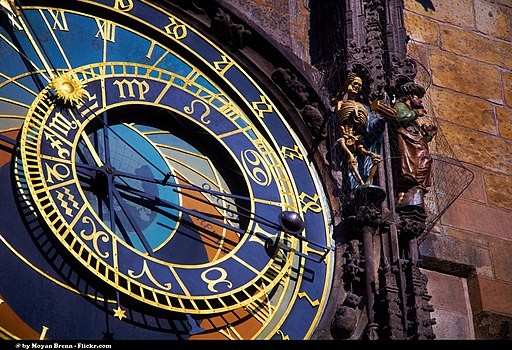Among the capital cities in Europe, Prague boasts some of the most well-preserved historic structures inspired by Baroque, Gothic, and Renaissance art. It has become famous to tourists for its castles, medieval squares, bridges, and cathedrals. One of the most photographed landmarks in the city is the Old Town Hall Tower, which holds the popular Prague Orloj or astronomical clock.

History of Prague Orloj
Like other astronomical clocks or Horologium, the famous version in Prague is a specially designed mechanism and dials meant to display astronomical information. Most indicate the relative positions of the Sun, Moon, Zodiac constellations, and other planets.
The Prague Astronomical Clock was first installed in 1410, making it the third-oldest astronomical clock in the world and the oldest still in operation today. The first mention of the clock was on October 9 of the same year.
For many years, it was assumed that the clock was designed and built by clock master Jan Růže. However, historical records revealed that it was first installed by clockmaker Mikuláš of Kadaň and astronomer and scientist Jan Šindel. Throughout time, the astronomical clock has undergone continuous maintenance and repair.
It was heavily damaged during World War II during the Prague uprising against Nazi forces. After the machinery was repaired, the Orloj started working again in 1948. Another major renovation took place in 2005, which involved restoring the lower calendar ring and statues. The last renovation program happened from January to September 2018 after the Old Town Tower was reconstructed. During this renovation, an electric clock that had been operating since 1948 was replaced by an original mechanism from the 1860s.
READ ALSO: Scientists Set a New Record with Most Accurate Clock Ever Built
How Does the Orloj Work?
From the outside, the clock looks like a color-coded, multi-layered, brightly painted clock face of golden twirls and arcane symbols. This masterpiece comprises three main parts: the calendar dial, the astronomical dial, and the "Walk of the Apostles."
The calendar dial, built by Josef Mánes, was added to the clock tower in 1865. It shows the days of the year and large medallions representing the 12 months. The writing along the edge of the calendar contains the names of 865 church holidays and saints.
The astronomical dial displays the current position of the Sun and Moon as seen on the clock hands. Its background shows Roman numerals, which were placed to indicate local time. Inside the dial is a black movable circle marked with zodiac signs. Completing the astronomical dial is a set of numbers that indicate Old Czech Time.
Two little doorways above the clock open at the top of the hour. Small statues of the Apostles can be seen parading out of the doorway and returning to the other side. As soon as the Apostles finish their journey, the bell rings, the golden rooster crows, and the clock chimes the hour. This will also be followed by a trumpet player that heralds the hour from the top of the clock tower.
Aside from its three main components, other moving figures are placed on Prague's astronomical clock. Four allegorical figures flanking the clock are set in motion every hour, representing vanity, greed, and death.
RELATED ARTICLE: Nuclear Clocks Breakthrough May Make It More Precise Than Ever, Revolutionizing Timekeeping and Quantum Sensor Technology
Check out more news and information on Clock in Science Times.











!['Cosmic Glitch' in Einstein's Theory of General Relativity Could Be Explained in This New Scientific Tweak [Study]](https://1721181113.rsc.cdn77.org/data/thumbs/full/53435/258/146/50/40/cosmic-glitch-in-einsteins-theory-of-general-relativity-could-be-explained-in-this-new-scientific-tweak-study.jpeg)


